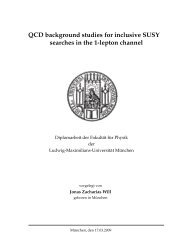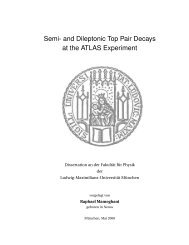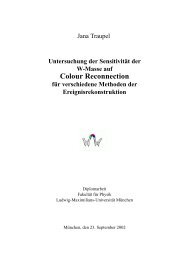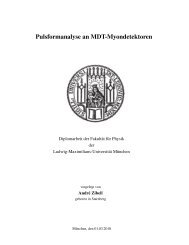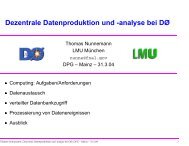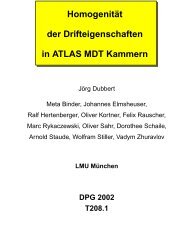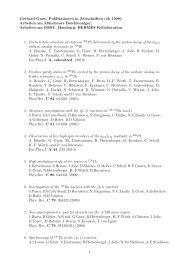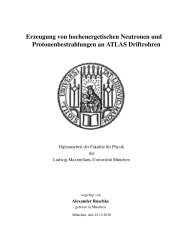development of micro-pattern gaseous detectors – gem - LMU
development of micro-pattern gaseous detectors – gem - LMU
development of micro-pattern gaseous detectors – gem - LMU
Create successful ePaper yourself
Turn your PDF publications into a flip-book with our unique Google optimized e-Paper software.
10 Chapter 1 Interactions <strong>of</strong> Charged Heavy Particle and Photons in Matter<br />
• The matter’s atomic number Z, atomic weight A and density ρ, the Avogadro number NA, it’s<br />
ionization potential I and the maximum energy transfer Tmax.<br />
The additional terms in the brackets refer to corrections, firstly the density effect δ which describes<br />
the screening <strong>of</strong> the incident particle’s electric field by the charge density <strong>of</strong> the atomic electrons.<br />
It can be neglected for gases under normal pressure thus it is important for dense absorbers. The<br />
second corrections C is due to the movement <strong>of</strong> the electrons in the shells .<br />
The energy loss decreases like 1/β 2 in the low momentum range and reaches a minimum near<br />
βγ ≈ 4. Comparing the minima <strong>of</strong> different absorbers one observes a decreasing energy loss at the<br />
ionization minimum with increasing atomic number <strong>of</strong> the absorber. These characteristics are mainly<br />
due to the Z/A term in Eq. 1.9 and is shown in Fig. 1.3.<br />
Figure 1.3: Mean energy loss rate in liquid<br />
hydrogen, <strong>gaseous</strong> helium, carbon, aluminium,<br />
iron, tin and lead. [PDG 10]<br />
Figure 1.4: Energy deposit measurements<br />
<strong>of</strong> different incident particle in a Time Projection<br />
Chamber (TPC) filled with Ar : CH4<br />
in ratio 80 : 20 at 8.5 atm pressure [PDG 10]<br />
Relativistic particle with βγ ≈ 4 are called minimum-ionizing particle (MIP). Their energy loss<br />
corresponds to the mentioned minimum. The logarithmic term in Eq. (1.9) provides an increasing<br />
energy loss for values <strong>of</strong> βγ ≈ 5...100. Large energy transfer per interaction is responsible for a large<br />
fraction <strong>of</strong> the rise in this energy range. These electrons, detached from the atom by large energy<br />
transfers, are called δ- electrons or knock-on electrons. The logarithmic or relativistic rise is followed<br />
by a constant plateau for βγ ≈ 500...1000, induced by the density effect. For incident particle with<br />
higher momentum (βγ ≫ 1000) the formula <strong>of</strong> Bethe-Bloch receives further corrections caused by<br />
radiation losses since Eq. 1.9 holds only for energy losses due to ionization and excitation.<br />
If the incident heavy charged particle is not traveling through a pure medium but a mixture <strong>of</strong> absorber<br />
materials or chemical compounds, the average energy loss per length can be approximated by Bragg’s<br />
additivity for the energy loss which is also named the stopping power in this context [Thwa 83]. Thus<br />
the average mass stopping power is:



